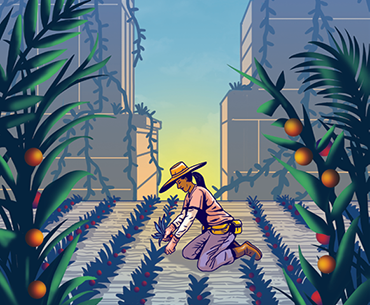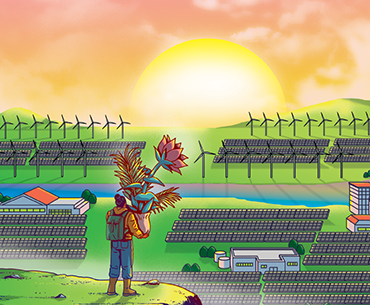Time to Indigenize Lands and Water Conservation
Native American activists are leading a push to embed traditional ecological knowledge in land management decisions
 Illustration by Glenn Harvey Whenever I see a bumper sticker that says "Decolonize the Land" or "Rematriate the Land" or, simply, "Land Back," I feel a little rush of pride and excitement. After all, few things are more important to Indigenous peoples than the return of stolen ancestral lands. These aren't, however, just sound-bite slogans; those words represent significant values, aspirations, and ways of living among Native peoples. They remind us how Native lands around the globe, including here in the United States, have been colonized. This colonization continues today in the form of logging, mining, and oil and gas drilling—processes of pillage euphemistically called "resource extraction" or "economic development." But there are also potent countermovements against this continued colonization, efforts to restore lands and waters to Indigenous guardianship and/or Indigenous stewardship. These movements seek to return the land to the original Mother and mothers of our cultures to begin the process of reparations, healing, and recovery. As the Anishinaabe activist and author Winona LaDuke says, "The only compensation for land is land."
Illustration by Glenn Harvey Whenever I see a bumper sticker that says "Decolonize the Land" or "Rematriate the Land" or, simply, "Land Back," I feel a little rush of pride and excitement. After all, few things are more important to Indigenous peoples than the return of stolen ancestral lands. These aren't, however, just sound-bite slogans; those words represent significant values, aspirations, and ways of living among Native peoples. They remind us how Native lands around the globe, including here in the United States, have been colonized. This colonization continues today in the form of logging, mining, and oil and gas drilling—processes of pillage euphemistically called "resource extraction" or "economic development." But there are also potent countermovements against this continued colonization, efforts to restore lands and waters to Indigenous guardianship and/or Indigenous stewardship. These movements seek to return the land to the original Mother and mothers of our cultures to begin the process of reparations, healing, and recovery. As the Anishinaabe activist and author Winona LaDuke says, "The only compensation for land is land."
We Indigenous peoples have cultural and spiritual obligations to embody Indigenous ideals of interrelations and to restore the balance between people and place. This is, of course, a huge challenge in a country focused on individualism and materialism, a country that carries the brutal legacies of settler colonialism. To decolonize is to make something whole again, to put together the fragments and shards that were broken by colonial guns and imperialist maps, as well as remove the other divisive boundaries that seek to separate, remove, enclose, control, and—if uncontrollable—destroy in the name of empire and capital, or even God. To decolonize is to deconstruct the capitalist worldview that commodifies land and living processes. To decolonize is to re-Indigenize the values and practices of reciprocal relationship in which community connection is key to resilience.
If one tries to translate the word land or water into different Indigenous languages, one soon finds that the words to describe these things actually describe processes. In many Indigenous languages, these entities are more like verbs than nouns, expressions that emphasize the dynamic flows of relationships and of life-affirming cycles. For example, Hawaiian activist Mark Paikuli-Stride defines the word aina—a word generally translated to mean "land"—as "that which nourishes you." In this sense, land isn't just a bit of earth but is a being linked to cosmologies of belonging and genealogical connections, an entity from which emerges the sacred foods of earth and sea. Likewise, botanist Robin Kimmerer shares that the Potawatomi word for a bay, wiikwegama, is actually a verb that means "to be a bay," since it is an animate being. Land and water are not things, nouns, or commodities. They aren't even natural resources. They are living processes, flows of energy and matter in motion across perceived boundaries, like the animacy and unity of water in our bodies, in plants, in rivers, and in the oceans.
It seems that many people, from all backgrounds and all walks of life, are hungry to redefine our relationships to the living world—to move from seeing land as private property that is available for exploitation and extraction to understanding land as flow and nourishment. How can we return, in a freshly imagined way, to understanding land as nourishment once again? What would it look like to turn those bumper sticker slogans into programs and policies for decolonization? To begin, we need to change how so-called public lands in the United States are governed as well as how they are stewarded.
We can look to Bears Ears National Monument, in southern Utah—created by President Obama, downsized by President Trump, and hopefully soon to be restored by President Biden—as a profound example of what it looks like when Native nations assert their leadership over ancestral lands. Five Indigenous nations spearheaded the effort to establish Bears Ears, and President Obama's order creating the monument explicitly gave those nations a formal voice in how the monument was to be managed. This system of Native leadership could and should be a model for other national parks and national forests. In the meantime, Indigenous peoples are creating innovative Native land trusts in rural and urban places to rematriate the land and increase food sovereignty, while others are developing integrated comanagement agreements on private lands to implement traditional burning practices. For example, the Native American Land Conservancy, a Native-controlled land trust in the Colorado and Mojave Deserts of California, is working with local tribes, landowners, federal agencies, and environmental organizations to purchase back, restore, and manage ancestral lands to protect sacred sites and renew cultural heritage. And Indigenous groups from Canada to Peru are creating new types of tribal parks and other Indigenous-protected areas.
But the 326 land areas administered as Indian reservations, which cover approximately 56 million acres, are dwarfed by the more than 800 million acres of federal public lands across the United States. All those federal public lands—every square inch of them—are Native American ancestral territories, from Yosemite National Park (home of the excluded Ahwahneechee) to Glacier National Park (home of the Blackfoot) to Everglades National Park (home of the Miccosukee). It's time to reassess the governance and guardianship of those lands and waters and collectively remember that Indigeneity is rooted in principles of ecological sustainability.
We need stewardship that is embedded in land-based cultural practices known as traditional ecological knowledge (TEK), the intergenerational land-care practices based on specific landscapes and tribal lifeways. These practices are as diverse as the tribal nations of this continent. Traditional knowledge keepers include the Yurok salmon fishers in the forested Northwest, Pueblo dryland farmers in the Southwest, Seneca moose hunters in the Northeast, and Muscogee green-corn gatherers in the Southeast. After learning from many Native California Indian land stewards, Euro-American author M. Kat Anderson referred to Native peoples' relationship to land as "tending the wild." Today, ecologists understand that small-scale ecosystem disturbances such as seasonally setting fires or coppicing trees and reeds can be important processes that create mosaics of habitat, which in turn produce fertile biodiversity and enriched ecosystem processes, all while providing food, medicine, clothing, and shelter. Some people now refer to this intimate interplay of human land tending and ecosystem resilience as "biocultural diversity" or "biocultural heritage." Most Native peoples would simply refer to it as "tending to all my relations."
This more holistic approach to land stewardship should represent the next paradigm of the conservation movement; it can be a way to directly address issues of historical and environmental injustice. Owing to the deeply embedded and often unconscious racist beliefs within the conservation movement, there historically has been little interest in understanding the sophisticated Indigenous science of working with natural processes in reciprocal ways. Conservationists have contributed to, and economically benefited from, the social construction of wilderness that sets nature as a place apart from humanity. The conservation movement's idea of protecting nature primarily as a space for white people's personal revelations and recreation has been one of the unexamined assumptions of conservationism. It is also an example of binary thinking, since it assumes that humans are either destroyers of nature (exemplified by early colonists and "savage Indians") or protectors of nature (transcendentalists, environmentalists, and romanticized "ecological Indians"). For far too long, there was no understanding of a middle path or recognition that Indigenous peoples lived with the natural world, utilizing it with minimal harm and, in many cases, enhancing the biodiversity of their homelands.
Even though much work still needs to happen to decolonize the conservation movement, traditional ecological knowledge and place-based Indigenous sciences are finally receiving some of the recognition they deserve. Many Indigenous peoples are willing to share their knowledge with Western ecologists and land managers, and tentative collaborations have shown how traditional ecological knowledge can work alongside scientific ecological knowledge to better address pressing environmental issues like climate change and watershed conservation. Land managers can incorporate lessons learned from Indigenous ecocultural restoration projects and seek comanagement partnerships with Indigenous fire managers, water protectors, basket weavers, seed gatherers, and hunters. Some national forest districts and other public lands, for example, have recently begun experimenting with Native American fire-management practices.
As the United States reckons with its colonial past and the damages of Native American dispossession, we must reimagine our methods of land stewardship—for the good of the planet and its many living beings. The conservation movement and government agencies can transform themselves by listening to and learning from Indigenous peoples and, in turn, offering support. That is how, together, we can decolonize our relationships with the land and water. We must honor and respect Indigenous peoples' environmental knowledge and lifeways and, in doing so, help restore totem keystone species and cultural keystone processes, from elderberry medicine to salmon migration. Such honor and respect can serve as a kind of cultural medicine and allow us to fulfill our sacred responsibility as humble members of this magnificent Earth.
This article appeared in the January/February edition with the headline "Time to Indigenize Conservation."
 The Magazine of The Sierra Club
The Magazine of The Sierra Club











